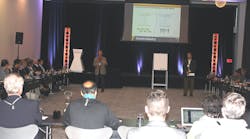When you think of having a discussion, you normally picture a small group of people sharing ideas back and forth in an intimate setting. What happens when you expand that group to over 100 people? As part of Smart Industry 2015, we decided to try just that, and what resulted was what I can safely say was the largest interactive discussion most people have ever experienced.
Mike Yost and David Frede lead the unConference discussion at Smart Industry 2015.
This open discussion, termed an “unConference” by the organizer Mike Yost, president of MESA International, was designed to be an interactive session where attendees bring their skepticism and out-of-the-box thinking and ask (or answer) pragmatic questions about how at least some of the big vision for the Industrial IoT might actually come to fruition.
Along with co-facilitator David Frede, Sr. Industry Consultant, Manufacturing and Supply Chain Global Practice at SAS, Mike started the unConference off with a very short presentation and then opened discussion up to the over 100 participants seated in a large U-shaped area of tables.
Though it took a bit of nudging on Mike and David’s part to get the conversation moving, move it did. Conversation ranged from connected tennis racquets to how manufacturers can gain value from. Here are just a few of the points attendees made during the hour-long conversation:
When talking about how manufacturers can make use of the data collected from equipment, one participant said that it’s like when you had a flip phone and now you have a smart phone. Maybe you didn’t know what you would do with a smart phone until you had it, but now you do everything with it. We’re now thinking that we have all these data points that are there, how do you connect them to make something useful? We’re in the beginning now and it’s hard to predict what will emerge.
Mike pointed out that you can look at all of this new IIoT technology as an opportunity or as a competitive threat. But one participant responded that sometimes it’s not up to whether or not you want to adopt. If your competitor has adopted and you have not, your business is basically totally destroyed.
Another participant thought that we now have an interesting opportunity. Traditionally we always thought: You take raw material, turn it into a product, and deliver it, and that’s the end of it. Unless you get feedback, you figure it’s done. But now we have the opportunity to extend that boundary, use sensors to collect data on the customer’s use of the product, and then fix or improve that product while it is already in the customer’s possession.
Someone else used drones as an example of the advantages smaller companies can take from IIoT without the necessity of a huge installation. Thinking about workforce efficiency, he said that earlier, operators needed to balance drones manually. Now, with sensors, that balancing is done automatically. This opens up the operator to do other things. So you don't always have to have big data to add big value.
One other participant gave an example that put everything into perspective: It’s important to think about how to use what you have. Kodak had first patent on the digital camera. Being first doesn’t always mean you’ll succeed.




